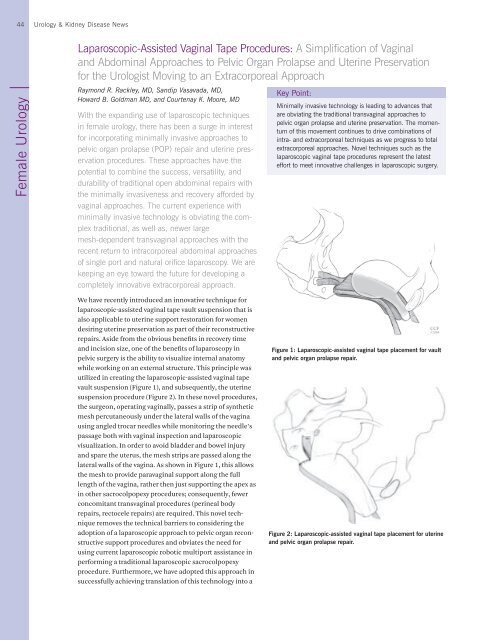Urology & Kidney Disease News - Cleveland Clinic
Urology & Kidney Disease News - Cleveland Clinic
Urology & Kidney Disease News - Cleveland Clinic
You also want an ePaper? Increase the reach of your titles
YUMPU automatically turns print PDFs into web optimized ePapers that Google loves.
44 <strong>Urology</strong> & <strong>Kidney</strong> <strong>Disease</strong> <strong>News</strong><br />
Female <strong>Urology</strong><br />
Laparoscopic-Assisted Vaginal Tape Procedures: A Simplification of Vaginal<br />
and Abdominal Approaches to Pelvic Organ Prolapse and Uterine Preservation<br />
for the Urologist Moving to an Extracorporeal Approach<br />
Raymond R. Rackley, MD, Sandip Vasavada, MD,<br />
Howard B. Goldman MD, and Courtenay K. Moore, MD<br />
With the expanding use of laparoscopic techniques<br />
in female urology, there has been a surge in interest<br />
for incorporating minimally invasive approaches to<br />
pelvic organ prolapse (POP) repair and uterine preservation<br />
procedures. These approaches have the<br />
potential to combine the success, versatility, and<br />
durability of traditional open abdominal repairs with<br />
the minimally invasiveness and recovery afforded by<br />
vaginal approaches. The current experience with<br />
minimally invasive technology is obviating the complex<br />
traditional, as well as, newer large<br />
mesh-dependent transvaginal approaches with the<br />
recent return to intracorporeal abdominal approaches<br />
of single port and natural orifice laparoscopy. We are<br />
keeping an eye toward the future for developing a<br />
completely innovative extracorporeal approach.<br />
We have recently introduced an innovative technique for<br />
laparoscopic-assisted vaginal tape vault suspension that is<br />
also applicable to uterine support restoration for women<br />
desiring uterine preservation as part of their reconstructive<br />
repairs. Aside from the obvious benefits in recovery time<br />
and incision size, one of the benefits of laparoscopy in<br />
pelvic surgery is the ability to visualize internal anatomy<br />
while working on an external structure. This principle was<br />
utilized in creating the laparoscopic-assisted vaginal tape<br />
vault suspension (Figure 1), and subsequently, the uterine<br />
suspension procedure (Figure 2). In these novel procedures,<br />
the surgeon, operating vaginally, passes a strip of synthetic<br />
mesh percutaneously under the lateral walls of the vagina<br />
using angled trocar needles while monitoring the needle’s<br />
passage both with vaginal inspection and laparoscopic<br />
visualization. In order to avoid bladder and bowel injury<br />
and spare the uterus, the mesh strips are passed along the<br />
lateral walls of the vagina. As shown in Figure 1, this allows<br />
the mesh to provide paravaginal support along the full<br />
length of the vagina, rather then just supporting the apex as<br />
in other sacrocolpopexy procedures; consequently, fewer<br />
concomitant transvaginal procedures (perineal body<br />
repairs, rectocele repairs) are required. This novel technique<br />
removes the technical barriers to considering the<br />
adoption of a laparoscopic approach to pelvic organ reconstructive<br />
support procedures and obviates the need for<br />
using current laparoscopic robotic multiport assistance in<br />
performing a traditional laparoscopic sacrocolpopexy<br />
procedure. Furthermore, we have adopted this approach in<br />
successfully achieving translation of this technology into a<br />
Key Point:<br />
Minimally invasive technology is leading to advances that<br />
are obviating the traditional transvaginal approaches to<br />
pelvic organ prolapse and uterine preservation. The momentum<br />
of this movement continues to drive combinations of<br />
intra- and extracorporeal techniques as we progress to total<br />
extracorporeal approaches. Novel techniques such as the<br />
laparoscopic vaginal tape procedures represent the latest<br />
effort to meet innovative challenges in laparoscopic surgery.<br />
Figure 1: Laparoscopic-assisted vaginal tape placement for vault<br />
and pelvic organ prolapse repair.<br />
Figure 2: Laparoscopic-assisted vaginal tape placement for uterine<br />
and pelvic organ prolapse repair.

















